Load MARC Order Records
Introduction
The Acquisitions Load MARC Order Record interface enables you to add MARC records to selection lists and purchase orders and upload the records into the catalog. You can both create and activate purchase orders in one step from this interface. You can also load bibs and items into the catalog.
Leveraging the match sets available in the cataloging MARC batch Import interface, you can also utilize record matching mechanisms to prevent the creation of duplicate records.
For detailed instructions on record matching and importing, see the cataloging manual.
Basic Upload Options
-
Click Acquisitions → Load MARC Order Records.
-
If you want to upload the MARC records to a new purchase order, then check Create Purchase Order.
-
If you want to activate the purchase order at the time of creation, then check Activate Purchase Order.
-
Enter the name of the Provider. The text will auto-complete.
-
Select an org unit from the drop down menu. The context org unit is the org unit responsible for placing and managing the order. It defines what org unit settings (eg copy locations) are in scope, what fiscal year to use, who is allowed to view/modify the PO, where the items should be delivered and the EDI SAN. In the case of a multi-branch system uploading records for multiple branches, choosing the system is probably best. Single branch libraries or branches responsible for their own orders should probably select the branch.
-
If you want to upload the records to a selection list, you can select a list from the drop down menu, or type in the name of the selection list that you want to create.
-
Select a Fiscal Year from the dropdown menu that matches the fiscal year of the funds that will be used for the order. If no fiscal year is selected, the system will use the organizational unit’s default fiscal year stored in the database. If not fiscal year is set, the system will default to the current calendar year.
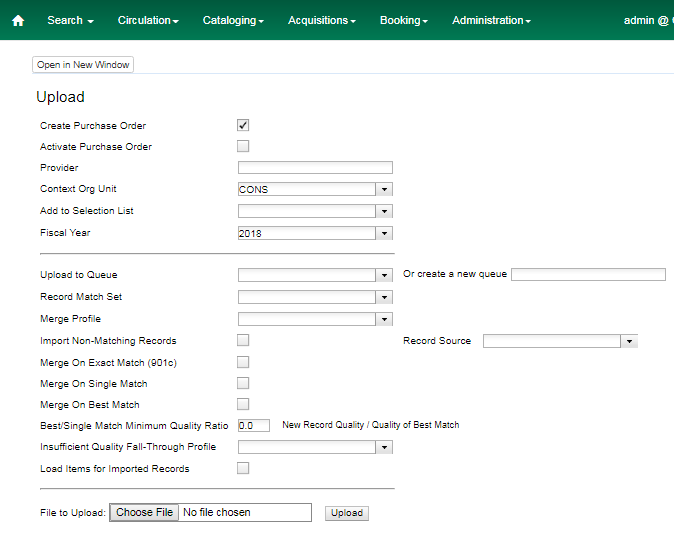
Record Matching Options
Use the options below the horizontal rule for the system to check for matching records before importing an order record.
-
Create a queue to which you can upload your records, or add you records to an existing queue
-
Select a Record Match Set from the drop-down menu.
-
Select a Merge Profile. Merge profiles enable you to specify which tags should be removed or preserved in incoming records.
-
Select a Record Source from the drop-down menu.
-
If you want to automatically import records on upload, select one or more of the following options.
-
Import Non-Matching Records - import any records that don’t have a match in the system.
-
Merge on Exact Match (901c) - use only for records that will match on the 901c field.
-
Merge on Single Match - import records that only have one match in the system.
-
Merge on Best Match - If more than one match is found in the catalog for a given record, Evergreen will attempt to perform the best match as defined by the match score.
-
-
To only import records that have a quality equal to or greater than the existing record, enter a Best/Single Match Minimum Quality Ratio. Divide the incoming record quality score, as determined by the match set’s quality metrics, by the record quality score of the best match that exists in the catalog. If you want to ensure that the inbound record is only imported when it has a higher quality than the best match, then you must enter a ratio that is higher than 1, such as 1.1. If you want to bypass all quality restraints, enter a 0 (zero) in this field.
-
Select an Insufficient Quality Fall-Through Profile if desired. This field enables you to indicate that if the inbound record does not meet the configured quality standards, then you may still import the record using an alternate merge profile. This field is typically used for selecting a merge profile that allows the user to import holdings attached to a lower quality record without replacing the existing (target) record with the incoming record. This field is optional.
-
If your order records contain holdings information, by default, Evergreen will load them as acquisitions copies. (Note: These can be overlayed with real copies during the MARC batch importing process.) Or you can select Load Items for Imported Records to load them as live copies that display in the catalog.

Default Upload Settings
You can set default upload values by modifying the following settings in Administration → Local Administration → Library Settings Editor:
-
Upload Activate PO
-
Upload Create PO
-
Upload Default Insufficient Quality Fall-Thru Profile
-
Upload Default Match Set
-
Upload Default Merge Profile
-
Upload Upload Default Min. Quality Ratio
-
Upload Default Provider
-
Upload Import Non Matching by Default
-
Upload Load Items for Imported Records by Default
-
Upload Merge on Best Match by Default
-
Upload Merge on Exact Match by Default
-
Upload Merge on Single Match by Default

Sticky Settings
If the above default settings are not implemented, the selections/values used in the following fields will be sticky and will automatically populate the fields the next time the Load MARC Order Records screen is pulled up:
-
Create Purchase Order
-
Activate Purchase Order
-
Context Org Unit
-
Record Match Set
-
Merge Profile
-
Import Non-Matching Records
-
Merge on Exact Match (901c)
-
Merge on Single Match
-
Merge on Best Match
-
Best/Single Match Minimum Quality Ratio
-
Insufficient Quality Fall-Through Profile
-
Load Items for Imported Records
Use Cases for MARC Order Upload form
You can add items to a selection list or purchase order and ignore the record matching options, or you can use both acquisitions and cataloging functions. In these examples, you will use both functions.
Example 1 Using the Acquisitions MARC Batch Load interface, upload MARC records to a selection list and import queue, and match queued records with existing catalog records.
In this example, an acquisitions librarian has received a batch of MARC records from a vendor. She will add the records to a selection list and a Vandelay record queue.
A cataloger will later view the queue, edit the records, and import them into the catalog.
-
Click Acquisitions → Load MARC Order Records
-
Add MARC order records to a Selection list and/or a Purchase Order. Check the box to create a purchase order if desired.
-
Select a Provider from the drop-down menu, or begin typing the code for the provider, and the field will auto-fill.
-
Select a Context Org Unit from the drop down-menu, or begin typing the code for the context org unit, and the field will auto-fill.
-
Select a Selection List from the drop down menu, or begin typing the name of the selection list. You can create a new list, or the field will auto-fill.
-
Create a new record import queue, or upload the records to an existing queue.
-
Select a Record Match Set.
-
Browse your computer to find the MARC file, and click Upload.

-
The processed items appear at the bottom of the screen.
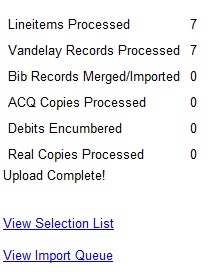
-
You can click the link(s) to access the selection list or the import queue. Click the link to View Selection List.
-
Look at the first line item. The line item has not yet been linked to the catalog, but it is linked to a record import queue. Click the link to the queue to examine the MARC record.

-
The batch import interface opens in a new tab. The bibliographic records appear in the queue. Records that have matches are identified in the queue. You can edit these records and/or import them into the catalog, completing the process.
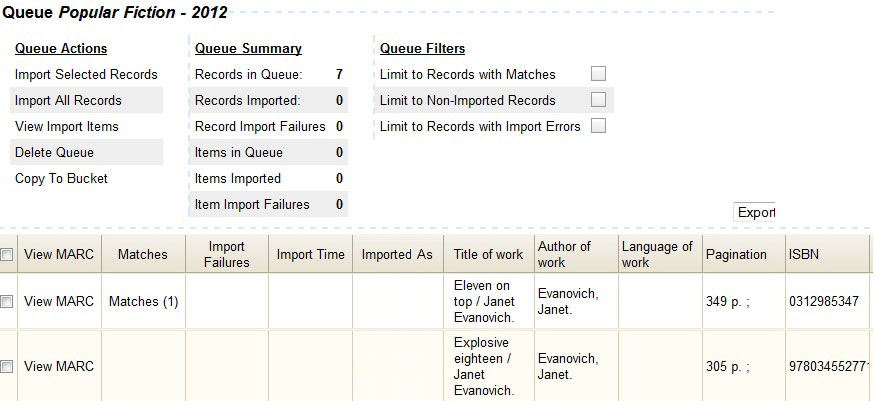
Example 2: Using the Acquisitions MARC Batch Load interface, upload MARC records to a selection list, and use the Vandelay options to import the records directly into the catalog. The Vandelay options will enable you to match incoming records with existing catalog records.
In this example, a librarian will add MARC records to a selection list, create criteria for matching incoming and existing records, and import the matching and non-matching records into the catalog.
-
Click Acquisitions → Load MARC Order Records
-
Add MARC order records to a Selection list and/or a Purchase Order. Check the box to create a purchase order if desired.
-
Select a Provider from the drop down menu, or begin typing the code for the provider, and the field will auto-fill.
-
Select a Context Org Unit from the drop down menu, or begin typing the code for the context org unit, and the field will auto-fill.
-
Select a Selection List from the drop down menu, or begin typing the name of the selection list. You can create a new list, or the field will auto-fill.
-
Create a new record import queue, or upload the records to an existing queue.
-
Select a Record Match Set.
-
Select Merge Profile → Match-Only Merge.
-
Check the boxes adjacent to Import Non-Matching Records and Merge on Best Match.
-
Browse your computer to find the MARC file, and click Upload.
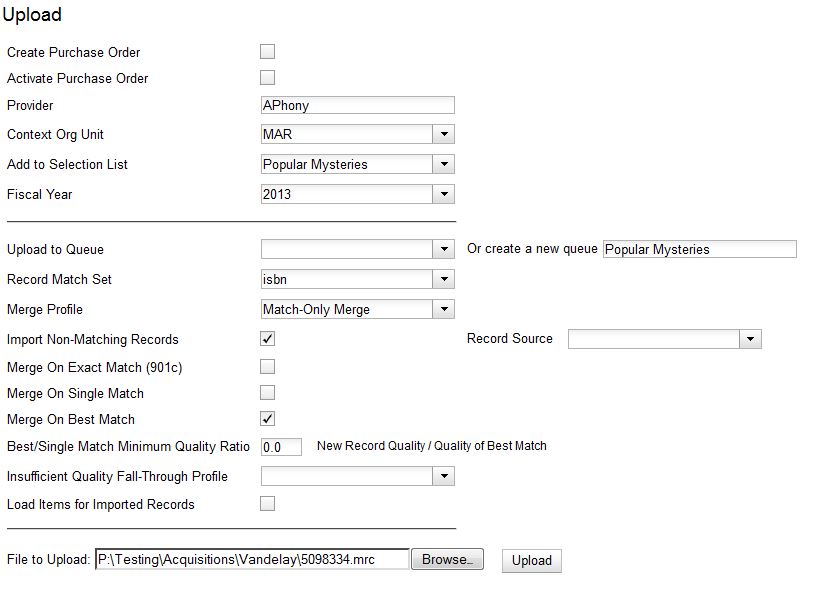
-
Click the link to View Selection List Line items that do not match existing catalog records on title and ISBN contain the link, link to catalog. This link indicates that you could link the line item to a catalog record, but currently, no match exists between the line item and catalog records. Line items that do have matching records in the catalog contain the link, catalog.
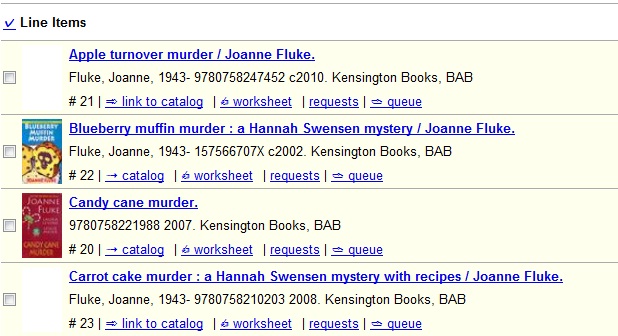
-
Click the catalog link to view the line item in the catalog.
Permissions to use this Feature
IMPORT_MARC - Using batch importer to create new bib records requires the IMPORT_MARC permission (same as open-ils.cat.biblio.record.xml.import). If the permission fails, the queued record will fail import and be stamped with a new "import.record.perm_failure" import error
IMPORT_ACQ_LINEITEM_BIB_RECORD_UPLOAD - This allows interfaces leveraging the batch importer, such as Acquisitions, to create a higher barrier to entry. This permission prevents users from creating new bib records directly from the ACQ vendor MARC file upload interface.